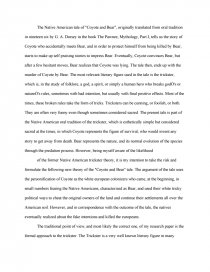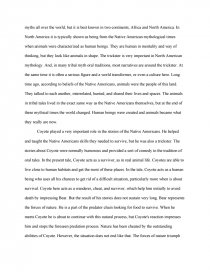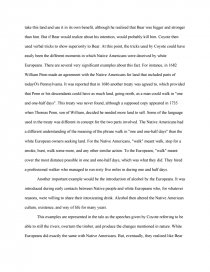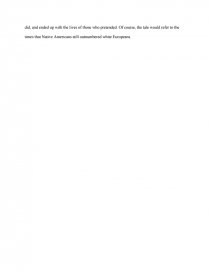Coyote and Bear
Essay by review • February 16, 2011 • Essay • 1,452 Words (6 Pages) • 1,772 Views
The Native American tale of "Coyote and Bear", originally translated from oral tradition in nineteen six by G. A. Dorsey in the book The Pawnee, Mythology, Part I, tells us the story of Coyote who accidentally meets Bear, and in order to protect himself from being killed by Bear, starts to make up self praising stories to impress Bear. Eventually, Coyote convinces Bear, but after a few hesitant moves, Bear realizes that Coyote was lying. The tale then, ends up with the murder of Coyote by Bear. The most relevant literary figure used in the tale is the trickster, which is, in the study of folklore, a god, a spirit, or simply a human hero who breaks godÒ's or natureÒ's rules, sometimes with bad intention, but usually with final positive effects. Most of the times, these broken rules take the form of tricks. Tricksters can be cunning, or foolish, or both. They are often very funny even though sometimes considered sacred. The present tale is part of the Native American oral tradition of the trickster, which is esthetically simple but considered sacred at the times, in which Coyote represents the figure of survival, who would invent any story to get away from death. Bear represents the nature, and its normal evolution of the species through the predation process. However, being myself aware of the likelihood
of the former Native American trickster theory, it is my intention to take the risk and formulate the following new theory of the "Coyote and Bear" tale. The argument of the tale uses the personification of Coyote as the white european colonizers who came, at the beginning, in small numbers fearing the Native Americans, characterized as Bear, and used their white tricky political ways to cheat the original owners of the land and continue their settlements all over the American soil. However, and in correspondence with the outcome of the tale, the natives eventually realized about the fake intentions and killed the europeans.
The traditional point of view, and most likely the correct one, of my research paper is the formal approach to the trickster. The Trickster is a very well known literary figure in many myths all over the world, but it is best known in two continents, Africa and North America. In North America it is typically shown as being from the Native American mythological times when animals were characterized as human beings. They are human in mentality and way of thinking, but they look like animals in shape. The trickster is very important in North American mythology. And, in many tribal myth oral traditions, most narratives are around the trickster. At the same time it is often a serious figure and a world transformer, or even a culture hero. Long time ago, according to beliefs of the Native Americans, animals were the people of this land. They talked to each another, interrelated, hunted, and shared their lives and spaces. The animals in tribal tales lived in the exact same way as the Native Americans themselves, but at the end of these mythical times the world changed. Human beings were created and animals became what they really are now.
Coyote played a very important role in the stories of the Native Americans. He helped and taught the Native Americans skills they needed to survive, but he was also a trickster. The stories about Coyote were normally humorous and provided a sort of comedy to the tradition of oral tales. In the present tale, Coyote acts as a survivor, as in real animal life. Coyotes are able to live close to human habitats and get the most of these places. In the tale, Coyote acts as a human being who uses all his chances to get rid of a difficult situation, particularly more when is about survival. Coyote here acts as a wanderer, cheat, and survivor, which help him initially to avoid death by impressing Bear. But the result of his stories does not sustain very long. Bear represents the forces of nature. He is a part of the predator chain looking for food to survive. When he meets Coyote he is about to continue with this natural process, but Coyote's reaction impresses him and stops the foreseen predation process. Nature has been cheated by the outstanding abilities of Coyote. However, the situation does not end like that. The forces of nature triumph once again in order to show a tale's moral. Bear acts in a more natural way. He finally concludes the cycle that his character was intended for, but not before showing an initial naпve personality. This situation creates a first impression on the reader/listener, implying that good convincing skills can defeat what is naturally expected to happen. However, and with full intention of developing a tale moral, these convincing skills only take effect on a temporary basis. The message this tale wants to issue is that nature might be unaware for some time, but at the end, it always defeats any intention of shortcutting the life cycle. This moral is among the most usual used in Native American coyote stories, which were normally told to audiences of young and old people alike. They were sometimes told to teach about cosmology, as instructional stories for the young, to explain history, and sometimes
...
...




